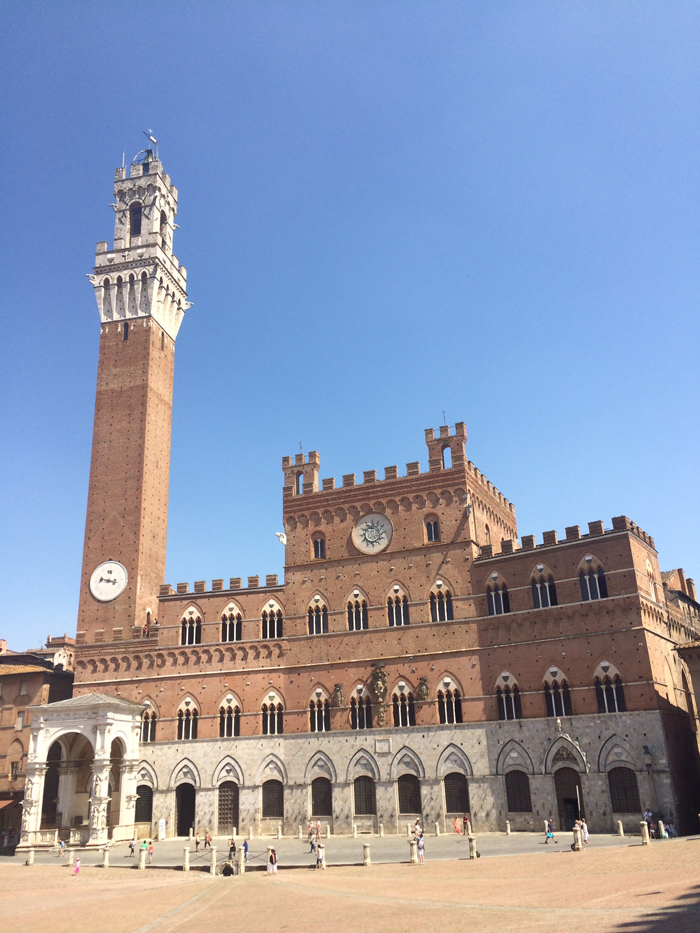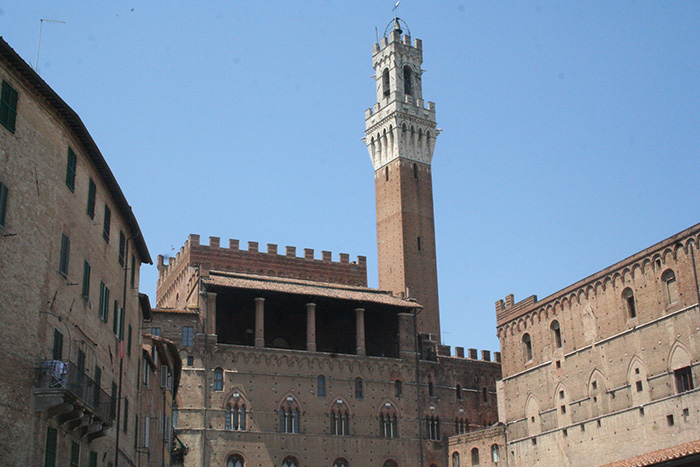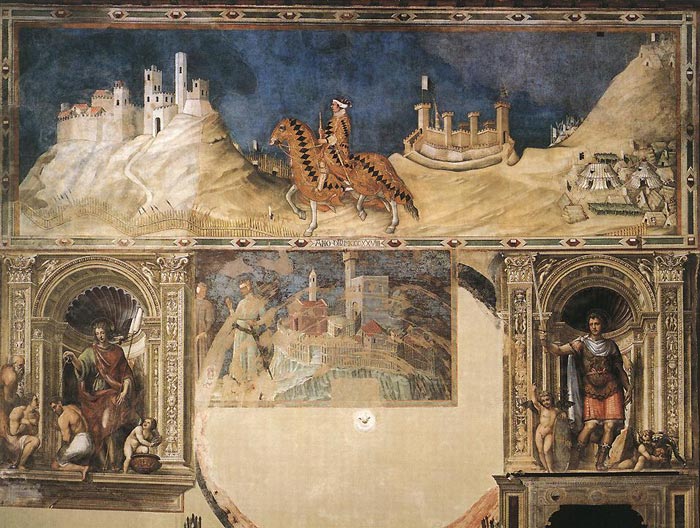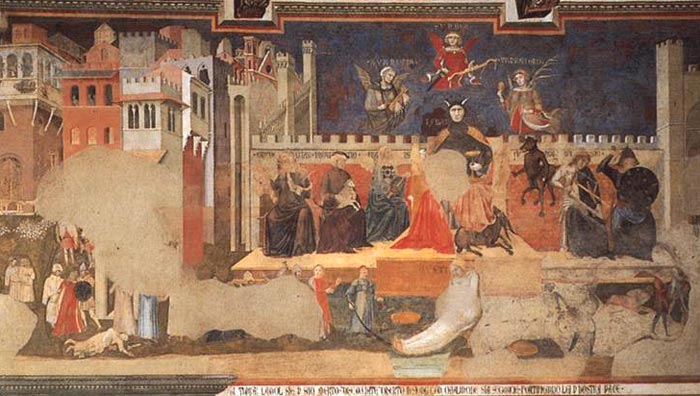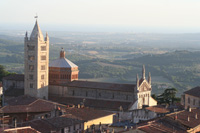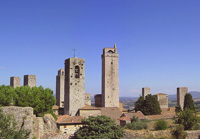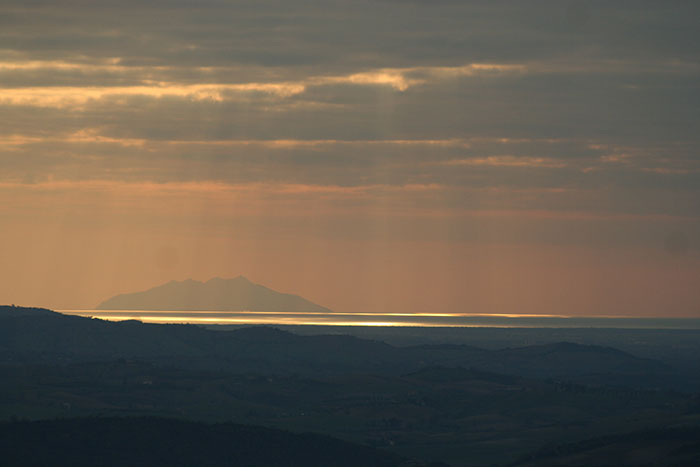| |
|
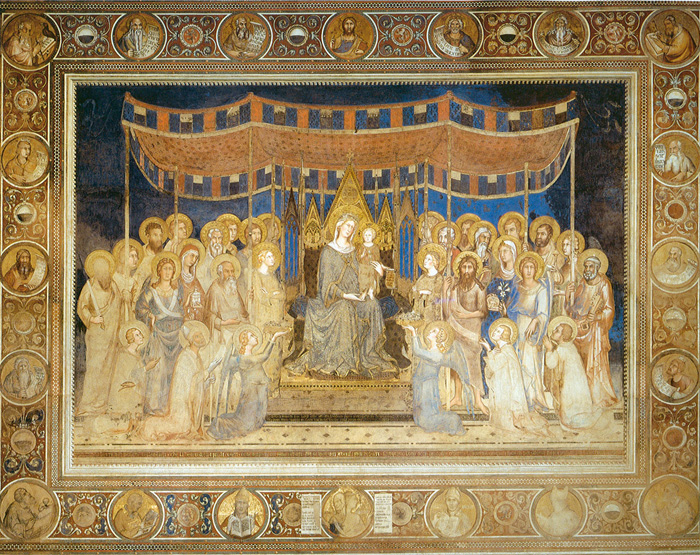
|
Simone Martini, Maestà (Madonna with Angels and Saints), 1312 - 1315, Sala del Mappamondo, Palazzo Pubblico, Siena
|
The Sala del Consiglio was constructed between 1304 and 1310, as part of the upper story of the central wing of the building. The first frescoes were executed soon after it was completed.
The fresco depicts the enthroned Madonna and Child with angels and saints. This painting, which is signed and dated 1315 but was retouched by Simone himself in 1321, is a free version of Duccio’s Maestà of 1308–11. But the hierarchic structure of Duccio’s work has been replaced by a growing interest in illusionary perspective, and the abstract character and lack of setting of the earlier work has given way to concrete concepts: Simone’s Virgin, crowned and splendidly attired, is a Gothic queen who holds court beneath a Gothic canopy.[1]
Surrounded by a frame decorated with twenty medallions depicting the Blessing Christ, the Prophets and the Evangelists and with smaller shields containing the coat-of-arms of Siena, the fresco shows a host of angels, Saints and Apostles, with the Madonna and Child in the centre. The whole scene, set against a deep blue background, is surmounted by an imposing canopy of red silk.
Simone Martini was probably apprenticed with Duccio di Buoninsegna (1255-1319), from whom he absorbed the technique of harmonizing colour . He is especially noted for his trecento experiments in using line for decorative purposes to such an extent that his mature works are almost abstract compositions.
The most obvious innovations present in Simone's style are his ideas of three-dimensional space. The supporting poles of the canopy are placed in perspective, thus giving a sense of depth to the composition. Under the canopy there is a crowd of thirty people: no more processions of people in parallel rows, but concrete spacial rhythms and animated gestures.
Art in Tuscany |Simone Martini | Maestà del Palazzo Pubblico di Siena Maestà (Madonna with Angels and Saints)
Facing the Maestà, Simone Martini painted another masterpiece in 1328, Guidoriccio da Fogliano all'assedio di Montemassi - Guidoriccio da Fogliano at the Siege of Montemassi, or the Equestrian Portrait of Guidoriccio da Fogliano.
|
Simone Martini, Equestrian portrait of Guidoriccio da Fogliano
|
|
Simone Martini, Equestrian portrait of Guidoriccio da Fogliano,1328-30, Palazzo Pubblico, Siena [1]
|
The fresco of Guidoriccio da Fogliano, depicting the conquest of the castles of Montemassi and Sassoforte in 1328, formed part of a fresco cycle "Castelli" which occupied the upper part of the wall opposite to the Maestà in the Sala del Mappamondo. It is one of the earliest of such commemorative images, and contains a vast panoramic landscape with the tents of the soldiers in the background. The cycle, commemorating the castles conquered by the Sienese, was initiated in 1314 by the representation of the Castle of Giuncarico, it was continued by the Guidoriccio and in 1331 by the Castles of Arcidosso and Piano. The latter were destroyed in 1361 when Lippo Vanni painted the Battles of Valdichiana and Poggio Imperiale. The figures in the niches on both sides are the patron saints of Siena, painted by Sodoma, an excellent Sienese master of the sixteenth century.
In the 1970s, the famous fresco, which had always been, considered the greatest example of Martini's artistic excellence, was re-attributed to a much later artist. The controversy that followed this re-attribution, further stimulated by the discovery of a fresco below the Guidoriccio (a very beautiful one, and certainly much older as we can see from the overlapping of the intonaco), turned into an animated diatribe that has not yet been placated.[1]
|
| |
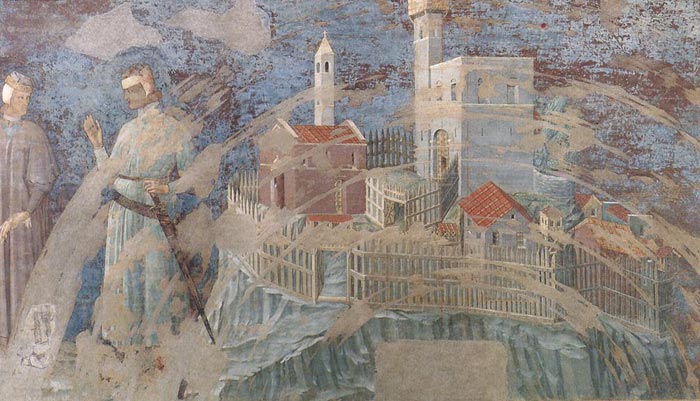 |
Unknown Master (first quarter of 14th century), Castle on a Hill, 1300-25, fresco in Palazzo Pubblico, Siena
|
|
During restoration work in 1979-80 in the Sala del Mappamondo of the Palazzo Pubblico in Siena, a new fresco was discovered below the imposing Guidoriccio da Fogliano by Simone Martini, representing a castle on a hill and two people in the foreground. The attempt to discover the identity of the unknown author of this work has given rise to much controversy among critics. Duccio, Pietro Lorenzetti, Memmo di Filippuccio, Simone Martini were suggested. The fresco, of outstanding executive quality both in skilful choice of descriptive detail and in its overall coherence, was badly damaged by the Mappamondo, a large, revolving, circular painting by Ambrogio Lorenzetti, which was placed on top of it in 1345.
Art in Tuscany | The Sala del Mappamondo (the World Map Room) and the lost wheel map of Ambrogio Lorenzetti
|
Sala della Pace
Ambrogio Lorenzetti, Allegory and Effects of Good and Bad Government
|
Next to the Sala del Mappamondo is the Sala della Pace or dei Nove, the most noteworthy of the rooms in the Palazzo Pubblico. Here the frescoes depict allegories of Good and Bad Government that were painted by the Sienese painter Ambrogio Lorenzetti between 1337 and 1339. In the picture showing Good Government, you can see a splendid view of Sienna as it was at that time.
|
 |
Ambrogio Lorenzetti, frescoes in the Sale del Pace, Palazzo Pubblico, Siena
|
Ambrogio Lorenzetti, Allegory of the Good Government
|
|
|
Ambrogio Lorenzetti's most revolutionary achievement - one of the most remarkable accomplishments of the Renaissance - is the fresco series that lines three walls of the room in the Palazzo Pubblico where Siena's chief magistrates, the Nine, held their meetings (Sala dei Nove). These frescoes are collectively known as Allegory and Effects of Good and Bad Government.
The subject of the frescoes are the Good and Bad Government and their effects on the life of the cities and villages.
The Allegory of the Good Government is situated on the smaller wall opposite to the windows. The composition is built up from three horizontal bands. In the foreground the figures of contemporary Siena are represented. Behind them, on a stage, there are allegoric figures in two groups, representing the Good Government. The two groups are connected by the procession of the councillors. The upper band indicates the heavenly sphere with the floating bodyless ghosts of the virtues.
|
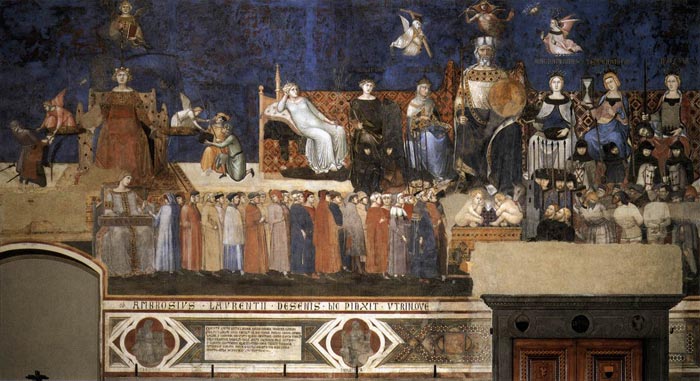 |
Ambrogio Lorenzetti, Allegory of the Good Government, fresco in the Palazzo Pubblico, Siena
|
The enthroned man on the right side of the middle band represents the city of Siena and embodies the Good Government. Around his head the four letters C S C V (Commune Saenorum Civitatis Virginis) explain his identity. At his feet the two plating children are the sons of Remus, Ascius and Senius, the founders of Siena according to the Roman legends. On both sides of Siena the virtues of Good Government are represented by six crowned, stately female figures: Peace, Fortitude and Prudence on the left, Magnanimity, Temperance and Justice on the right. On the far left of the fresco the figure of Justice is repeated as she is balancing the scales held by Wisdom.
The Allegory of Good Government depicts the personification of Justice as a woman. She gestures to the scales of balance, held by the personifcation of Wisdom floating over her throne. On the viewer's left, a convicted criminal is beheaded; on the right, figures receive the rewards of justice. At Justice's feet, the personification of Virtue, also, unusually for the time, portrayed as a female figure, passes virtue among twenty four faithfully rendered and recognizable images of prominent male citizens of Siena. The men face towards the largest figure in the image, a judge located in the center right. The judge is surrounded by additional personifications including Peace, who is represented as a fashionable, white-clad contemporary female figure with elaborate blonde hair. (Then as now, blonde hair was fashionable and seldom entirely natural; it was not the dominant natural hair color for Italian women from this region, and it was common for women to lighten their hair by streaking it with urine and heating it in the sun.)
The allegory carries a strong social message of the value of the stable republican government of Siena. It combines elements of secular life with references to the importance of religion in the city at the time. The figure of Justice resembles the figure of Mary, Queen of Heaven, the patron saint of Siena, on a throne. The Judge reflects the tradition in the Christian Last Judgment to have God or Christ judging the saved on the left; the damned on the right. While classified as medieval or proto (pre)-renaissance art, these paintings show a transition in thought and an evolution in theme from earlier religious art.
Flanking the Allegory are two other paintings on perpendicular walls: Effects of Good Government and Effects of Bad Government. Both these frescoes depict a recognizable view of Siena and its countryside.
In the allegorical representation of Good Government, the prosperous townspeople are trading and dancing in the streets. Beyond the city walls is a lush countryside in which crops are harvested.
In the allegory of Bad Government, crime is rampant and diseased citizens roam a crumbling city. The countryside suffers from drought.
|
| |
|
|
|
Ambrogio Lorenzetti, Effects of Good Government on the City Life (detail), fresco in the Palazzo Pubblico, Siena
|
Ambrogio Lorenzetti, Effects of Good Government on the City Life (detail)
|
The Effect of the Good Goverment is situated on the longer wall of the room. This panoramic fresco represents several scenes indicating the life of Siena and its environment in the 14th century. This detail shows the centre of the city. In the middle the dancing young women probably represent the nine Muses. There are several genre like scenes in the picture (shops, chatting men, riders, working men on the roof etc.)[3]
'Lorenzetti is the first painter in the west to be aware of the presence of both the urban and rural landscape, and the formal and compositional characteristics make this masterpiece unique of its kind. As a work entirely of self-representation too, it is, and has remained, unique: the walled city and the agricultural scene are two distinct social and spatial partitions, yet inter-communicating and fully integrated with each other. Man, animals and rural products are shown inside the town walls while the civic nobility goes out to visit the countryside.
On the one hand it could be said that the city dominates the country visually, architecturally and politically, yet at the same time the image of the farm worker expresses an awareness of the interwoven existence of the two components, the reassuring fertility of the fields and harvests which produce an abundance of supplies, the industriousness of men placed in a social order that exalts the reciprocal usefulness of all inhabitants. [3b]
|
| |
|
|
|
Ambrogio Lorenzetti, Bad Government and the Effects of Bad Government on the City Life (detail), fresco in the Palazzo Pubblico, Siena
|
Ambrogio Lorenzetti, Bad Government and the Effects of Bad Government on the City Life (detail)
|
On the wall opposite the Effect of Good Government and to the left of the Good Government Ambrogio painted another fresco called Bad Government and the Effects of Bad Government on the City Life, which uses the same forms and compositional devices as the other frescoes in the room, but inverts them. The malevolent-looking figure representing Bad Government, pointedly labeled as Tyranny, is enthroned and stares hieratically out at the observer. Neither male nor female, it is fanged, cross-eyed, and porcine, clearly bloated with corruption. In place of the cardinal virtues, personifications of Avarice, Pride, and Vainglory fly over its head. Tyranny is flanked by clearly labeled seated figures representing Cruelty, Treason, and Fraud at the left, and Frenzy, Divisiveness, and War at the right. A bound figure representing Justice lies at its feet. The city to its left is falling into ruin, robbers roam the streets, and, in the foreground, a group of ruffians drags a woman by her hair. Even in its now ruinous condition the image conveys a dire warning.[4]
|
| |
|
|
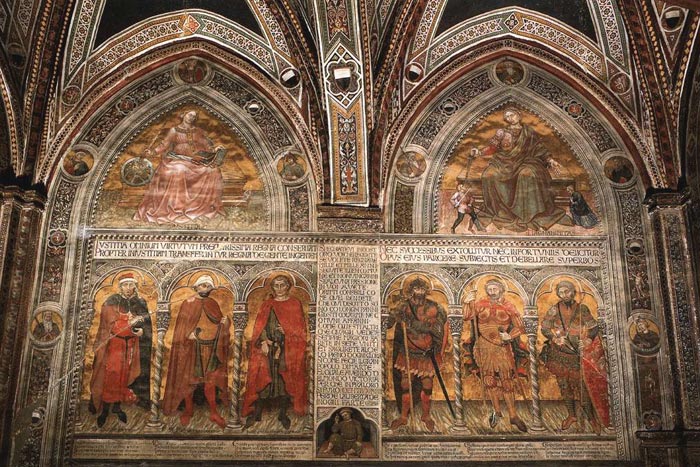 |
Justice with Cicero, M. Porcius Cato, and P. Scipio Nasica and Magnanimity with Curius Dentatus, Furius Camillus, and Scipio Africanus, 1413-14, commissioned by the Priors from Taddeo di Bartolo for the Antechapel in Palazzo Publico
|
Taddeo di Bartolo, Allegories of Justice and Magnanimity, 1414
|
| In 1412-14 the Priors of the Palazzo Pubblico commissioned Taddeo di Bartolo to paint a cycle of paintings for the antechapel of the Palazzo Pubblico, a space that functioned as an important passage between other rooms of the palace. On one wall, shown in this picture, Taddeo painted allegories of Justice and Magnanimity under the two arches; beneath each he placed a figure from Roman history exemplifying the concept. Below Justice (at left) there are Cicero, M. Porcius Cato, and P. Scipio Nasica; below Magnanimity (at right) Curius Dentatus, Furius Camillus, and Scipio Africanus. Each group of Roman heroes is labeled with an inscription in Latin, and each figure bears a further Latin Inscription below his feet. The inscriptions between M. Curius Dentatus and F. Furius Camillus claim them as founders of Siena, while others under Cicero and Cato speak of their fight for liberty and justice. |
|

Taddeo di Bartolo , Cesar and Pompey, 1414, fresco Palazzo Publico, Antechapel, Siena |
| |
|
|
 |
Lippo Vanni, Victory of the Sienese Troops at Val di Chiana in 1363
|
Lippo Vanni, Victory of the Sienese Troops at Val di Chiana in 1363
|
Accompanying Simone Martini's Maestà in the Sala del Mappamondo (formerly known as Sala del Consiglio) were a number of secular images. Frescoes commemorated battles and important military captains. One of the best surviving examples of this reportorial art was commissioned from the painter and miniaturist Lippo Vanni to record the Sienese victory in the Val di Chiana over English mercenaries in 1363. His monochromatic fresco records the progress of the battle and the disposition of the troops episodically across the wall; it is a graphic chronicle of the event rather than a naturalistic reconstruction, with cities carefully labeled and the armies identified by the heraldic flags of their leaders.
He was a miniaturist, and painted for the Spedale in 1344. In 1352 he executed a Coronation of the Virgin for the Biccherna. In 1359, together with Nello Betti, he executed some work in the Palazzo Pubblico, and in 1372 he painted an Annunciation for the cloisters of San Domenico at Siena, portions of which work still exist.
|
| On the walls facing of the windows are the Battaglia della Val di Chiana - Battle of Val di Chiana - a work by Lippo Vanni (1363) and the Battaglia del Poggio Imperiale contro i fiorentini - Battle against the Florentines at Poggio Imperiale - by Giovanni di Cristofano Ghini and Francesco d’Andrea (1480). Below these two paintings is a gallery of Siena’s most venerated saints: San Bernardino by Sano di Pietro, painted the year he was canonised (1450); Santa Caterina by Vecchietta (1460) and the Beato Bernardo Tolomei, founder of the Olivetani, by Sodoma (c.1530). |
|
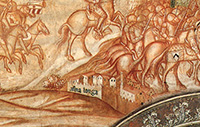
Sinalunga
|
|
|
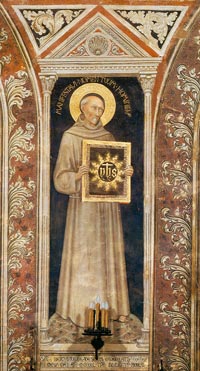
Sano di Pietro, Bernardino and his IHS Monogram Tablet (Sala del Mappamondo, Palazzo Pubblico, Siena). “IHS” is an abbreviation of the Greek form of Jesus’ name).
|
 |
Domenico Beccafumi, The Reconciliation of Marcus Emilius Lepidus and Fulvius Flaccus (1529-35), fresco in Palazzo Pubblico, Siena
|
Domenico Beccafumi | Frescoes of scenes from roman history (1529-1535)
|
The passageway, known also as the Sala dei Cardinali leads to the Sala del Concistoro, with an internal doorway in marble by Bernardo Rossellino. The brightly coloured frescoes on the ceiling were completed between 1529 and 1535 by Domenico Beccafumi, once more a representation of themes related to justice and patriotic devotion that take their cue from the Lorenzetti Good Government and the di Bartolo Illustrious Men cycles.
Domenico Beccafumi (1486 – 1551), born in Montaperti, near Siena, was an Italian Renaissance-Mannerist painter active predominantly in Siena. Originally named Domenico di Pace, and also called Il Mecherino, he took the name Beccafumi from his patron, a wealthy Sienese who sent him to study in Siena and Rome. He is considered one of the last undiluted representatives of the Sienese school of painting, and the most brilliant exponent of Mannerist art in Siena. Domenico Beccafumi was in Rome as a young man, from 1510 to 1512, where he became familiar with the work of Raphael and Michelangelo. Even though he worked in Siena for most of his life, he traveled also to Florence, Genoa (where he encountered the elegant Raphaelesque style of Perin del Vaga), and Pisa (where he painted two canvases in the apse of the cathedral). Beccafumi’s art is characterized by imaginative design and draftsmanship and by subtle atmosphere and the play of light and shadow.
Beccafumi designed 35 splendid mosaics from 1517 to 1546 for the pavement in Siena Cathedral, each mosaic depicting a different Old Testament scene. Beccafumi's best-known paintings are the ceiling frescoes of the Palazzo Publico in Siena and an altarpiece in the same building. Most of his best works, such as the Birth of the Virgin (c. 1543) are in Siena.[5]
Next to the Sala del Concistoro is the Sala di Balia, also known as Sala dei Priori. This room is adorned with frescoes by Spinello Aretino (1407) illustrating the Life of Pope Alexander III dei Bandinelli.
|
|
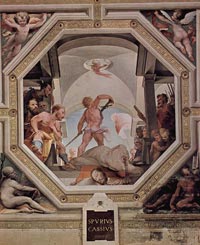 One of the scenes of Roman Justice frescoed on the ceiling of the Sala del Concistoro of the Palazzo Pubblico by Beccafumi between 1529-1535. |
The Loggia
|
|
|
 |
|
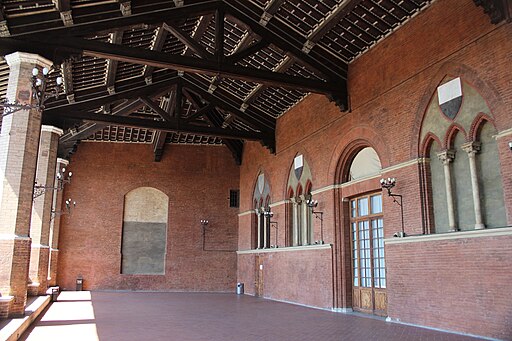 |
|
 |
Loggia superiore del Palazzo Pubblico, Siena
|
|
Loggia dei Nove del Palazzo Pubblico |
|
Ambrogio Lorenzetti, Madonna col Bambino (Maestà della Loggia del Palazzo Pubblico di Siena, 1340
|
| |
|
|
|
|

Art in Tuscany | The Sala del Mappamondo (the World Map Room) and the lost wheel map of Ambrogio Lorenzetti
Art in Tuscany | The Guidoriccio fresco: a new attribution: Thomas de Wesselow argues that the celebrated fresco, traditionally known as Guidoriccio, in Siena's Palazzo Pubblico, is not by Simone Martini, and proposes an alternative candidate.
David Murphy, Condottiere 1300-1500: Infamous Medieval Mercenaries (Warrior) |
Lavishly illustrated with contemporary depictions and original artwork, this title examines the complex military organization, recruitment, training and weaponry of the Condottieri. With insight into their origins and motivations, the author, Dr David Murphy, brings together the social, political and military history of these powerful and unscrupulous men who managed to influence Italian society and warfare for over two centuries.
Virtual visit | www.sienaguidavirtuale.it
|
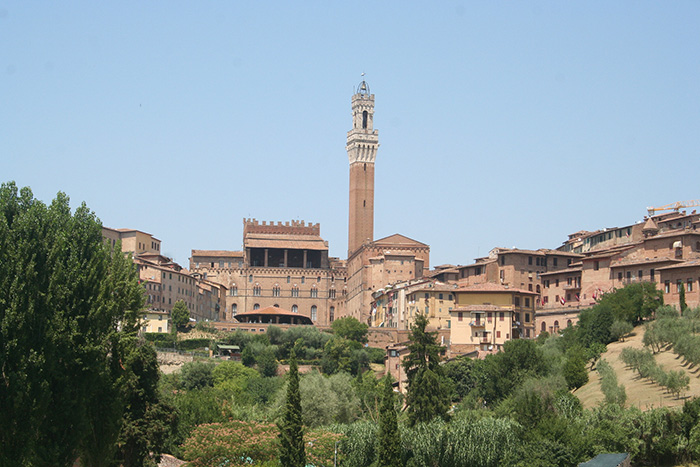 |
Palazzo Pubblico and Torre del Mangia, view from Orto de'Pecc
i
|
Inside the valley of Porta Giustizia it is possible to visit the 'medieval garden' L'Orto de'Pecci. The valley of Porta Giustizia, under Piazza del Mercato, is one of the best preserved green areas inside the old Walls of Siena. It has always been an ideal territory tor cultivation: it is watery and plan, beyond the uphill road called Via di Porta Giustizia. The name of the area, "Orto de' Pecci", refers to this function ('orto' means garden) and to the name of the family (the 'Pecci') which had owned the land tor a long time in the past.
L’Orto de’ Pecci comprises an exellent restaurant and bar, All'Orto de'Pecci.
It is our favorite restaurant in Siena.
Gardens in Tuscany | L'Orto de'Pecci
All'Orto de'Pecci
Via Porta Giustizia, 39, 53100 Siena SI
Telefono: 0577 222201
www.ortodepecci.it
|
|
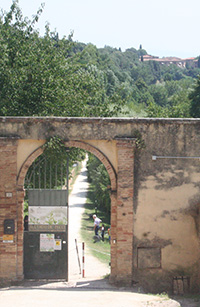
Porta Giustizia, the entrance of L'orto de'Pecci, beyond Piazza Mercato |
 |
|
|
[1] This fresco is situated below the Guidoriccio and is variously attributed, but convincingly argued to be the real Guidoriccio by Simone.
There is evidence of marks around the face and figure, consistent with damage caused by the throwing of pallets. When the fresco was uncovered, the figure was hidden by a cover of blue paint. Guidoriccio was a mercenary soldier, who changed sides in 1333 and fought for the opposition. It appears far more convincing that the citizens of Sienna would show their disapproval in this way, rather than celebrating a portrait in their town hall of a person who had become their enemy and a traitor to them. The grooves are left by the rotation of the Carte Topa grafica installed in the 15th Century.
At the turn of the century, in a foot note to his volume on fourteenth century Siena, Adolfo Venturi stated that the figure on horse back was not a Simone Martini but was added as a figure to go with the map on the wall below - there are various iconographical disparities which substantiate his claim. Venturi attributed the mappammondo to Abbrogio Lorenzetti. This important observation was not repeated in any subsequent art historical literature GM: "It's one thing to have something published, it's another to have it discussed by future scholars I missed it myself. In 1977 I could have been accused of plagiarism: He saw the same thing."Gordan Moran has been campaigning with his colleague Michael Mallory, since the late seventies, for the reassessment of the Guidorccio da Fogliano fresco in the Plazzo Publico in Siena. He has contested its attribution to Simone Martini (c1284-1344) on many fronts. Despite what appears to be conclusive evidence the art establishment and government of Siena maintain the accepted attribution and have employed many techniques to discredit the findings of Gordon Moran (not stopping at the manipulation of evidence to make their case appear in a better light.) This controversy has added importance because it is holding up the possible discovery of other frescos, in the same room, that would be of the greatest artistic and art historical value. [Heretics 1: The Simone Martini Cover-up]
[2] Frescoes of the Good and Bad Government by Ambrogio Lorenzetti | Web Gallery of Art, www.wga.hu
[3] Effects of Good Government on the City Life (detail)
[3b] Meoni, Maria Luisa. 2005. Utopia and Reality in Ambrogio Lorenzetti’s Good Government. Edizioni ITI, Florence, pp. 23-27.
[4] Bad Government and the Effects of Bad Government on the City Life
[5] Palazzo Pubblico (Siena) - Frescos by Domenico Beccafumi - Wikimedia Commons
[6] Source: Simone Martini | biography - Italian painter | www.britannica.com |
|
 |
|
|
|
![]()
![]()
![]()
![]()
![]()

